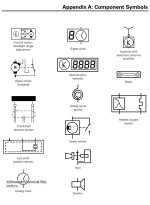Admin
Создатель сайта
Команда форума
- Сообщения
- 11 163
- Реакции
- 4 411
- Город
- Россия, Москва
- Авто
- VW Tiguan 2.0 DBGC 2018, VW Touran 1.6 BSE 2008
How to Read Wiring Diagrams
Self-Study Program
(для перевода используйте в браузере правую кнопку мыши -> "перевести на русский" )
Introduction
Wiring Diagram Overview, Layout
Navigation
Elements of a wiring diagram, Symbols, DIN 72 552
Introduction to Conductors, Wires, Wire colors, Wire sizes, Other Conductor descriptions
Connector Pin Assignments
Components
Layout
Practical Examples
Navigation 1, Navigation 2
Navigation 3, Navigation 4
Appendix A: Component Symbols
Appendix B: Wiring Connections
Appendix C: Component Codes and Wiring
Appendix D: DIN Standards.
Appendix E: Wiring Diagrams
Glossary
Course goals
This course will enable you to:
• Follow current from its power source to the Ground point quickly and accurately.
• Understand the symbols of common components and circuit designations used in Volkswagen Wiring Diagrams.
• Practice Wiring Diagram navigation through practical exercises and hands on examples.
Introduction
As today’s vehicles become increasingly complex, so does the job of the technician.
Wiring diagram navigation skills are critical to diagnosing and repairing today’s vehicle in a timely and accurate manner.
This Self Study Program is not intended to instruct the technician how the electrical system operates in a vehicle.
Given an understanding of electrical operation, this Self Study Program will introduce you to the skills necessary to read Volkswagen wiring diagrams.
In this program you will be exposed to all aspects of wiring diagrams, including:
• Commonly used symbols and their meanings
• Current tracks, including how to follow circuits between pages or diagrams
• Component identification
• DIN standards for terminal designations
• Wiring color codes and gauge (size)
• Terminal identification on both connectors and components
Self-Study Program
(для перевода используйте в браузере правую кнопку мыши -> "перевести на русский" )
Introduction
Wiring Diagram Overview, Layout
Navigation
Elements of a wiring diagram, Symbols, DIN 72 552
Introduction to Conductors, Wires, Wire colors, Wire sizes, Other Conductor descriptions
Connector Pin Assignments
Components
Layout
Practical Examples
Navigation 1, Navigation 2
Navigation 3, Navigation 4
Appendix A: Component Symbols
Appendix B: Wiring Connections
Appendix C: Component Codes and Wiring
Appendix D: DIN Standards.
Appendix E: Wiring Diagrams
Glossary
Course goals
This course will enable you to:
• Follow current from its power source to the Ground point quickly and accurately.
• Understand the symbols of common components and circuit designations used in Volkswagen Wiring Diagrams.
• Practice Wiring Diagram navigation through practical exercises and hands on examples.
Introduction
As today’s vehicles become increasingly complex, so does the job of the technician.
Wiring diagram navigation skills are critical to diagnosing and repairing today’s vehicle in a timely and accurate manner.
This Self Study Program is not intended to instruct the technician how the electrical system operates in a vehicle.
Given an understanding of electrical operation, this Self Study Program will introduce you to the skills necessary to read Volkswagen wiring diagrams.
In this program you will be exposed to all aspects of wiring diagrams, including:
• Commonly used symbols and their meanings
• Current tracks, including how to follow circuits between pages or diagrams
• Component identification
• DIN standards for terminal designations
• Wiring color codes and gauge (size)
• Terminal identification on both connectors and components
Последнее редактирование:




